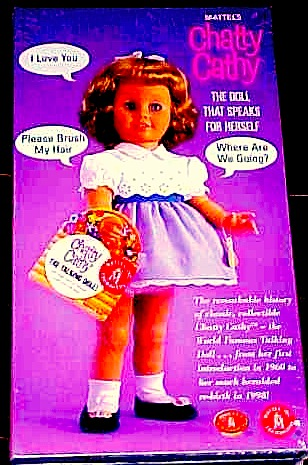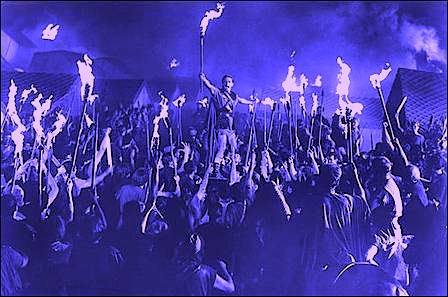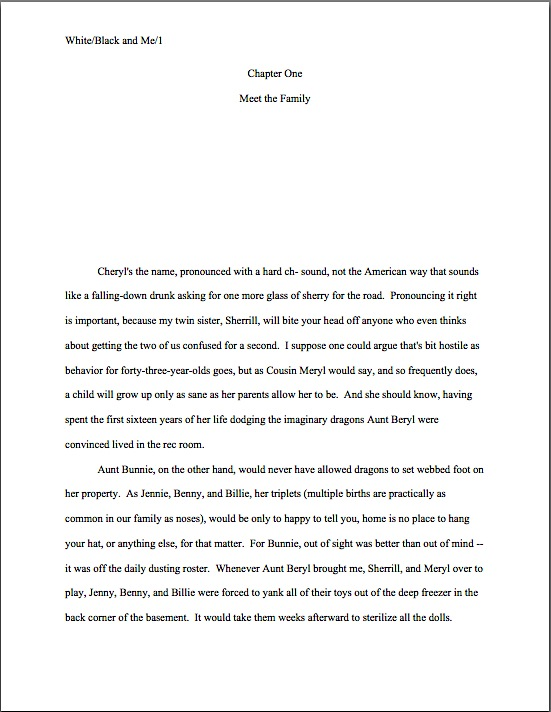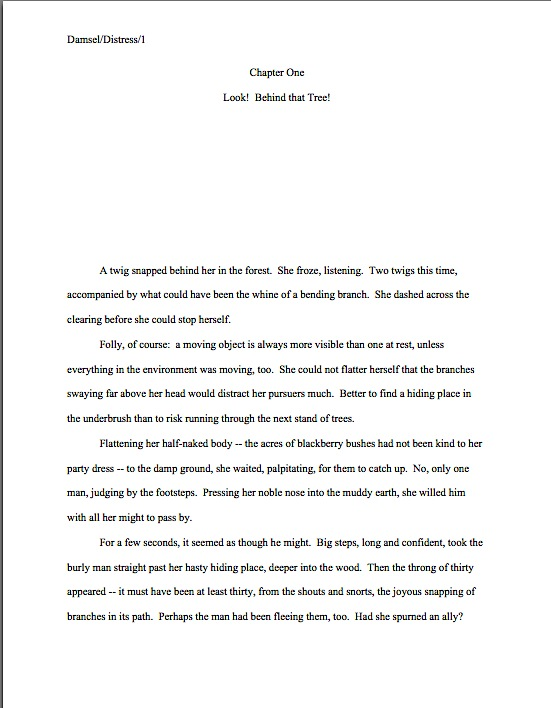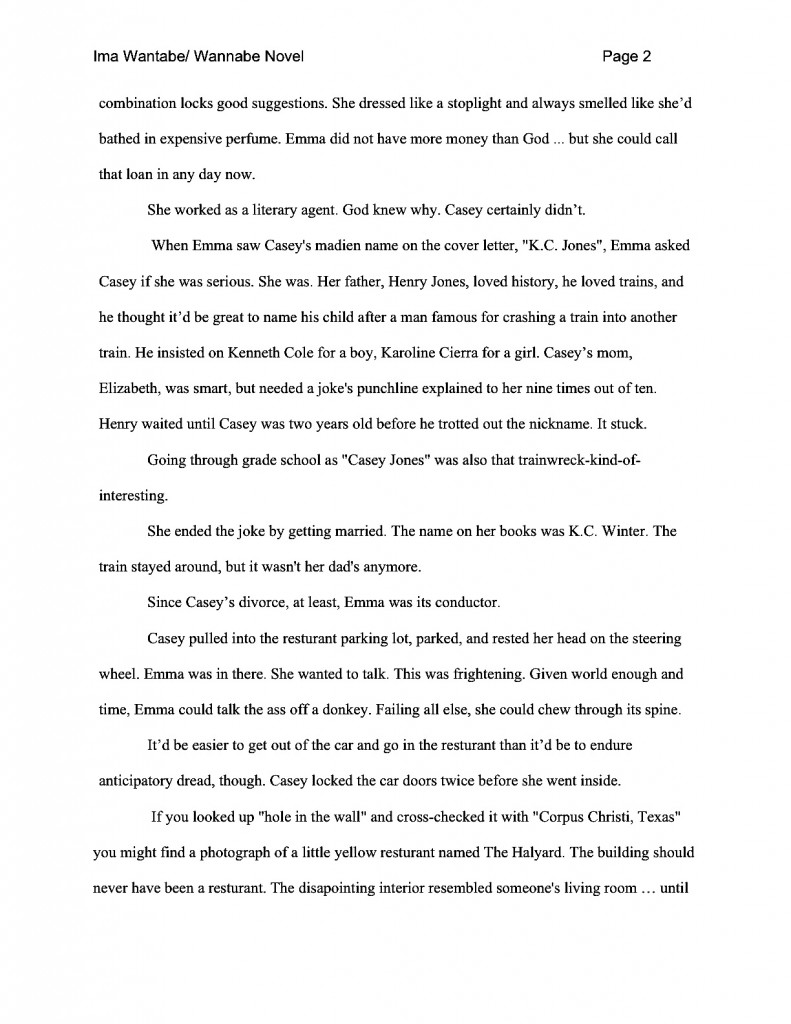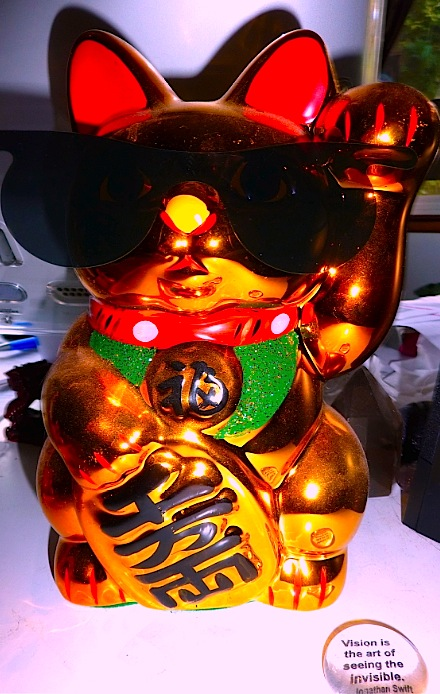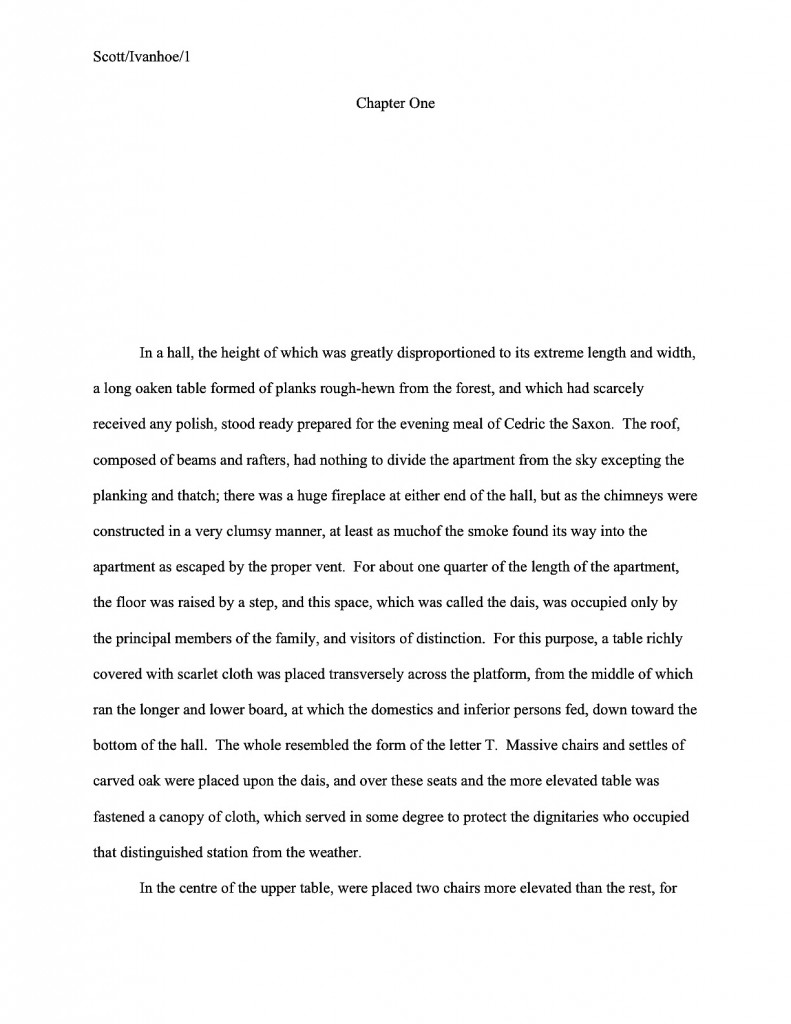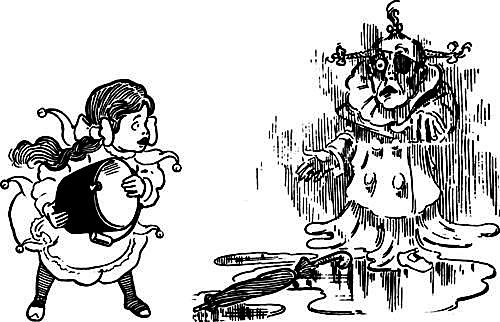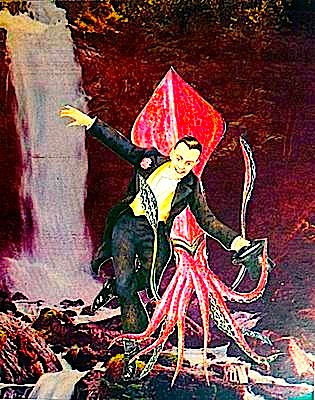
No time for my usual weighty tome today, I’m afraid: the houseguests, they are a-coming. As in any minute.
So let’s cut right to the chase and continue yesterday’s discussion of, well, when it is and isn’t a good idea to cut to the chase in a dialogue scene. Specifically, in that ubiquitous species of dialogue where one character is trying to elicit information from another.
In my last post, I brought up how frustrating many professional readers find it when a narrative forces them to follow a poor interviewer through an information-seeking process that seems one-sided or lacking in conflict. Or when — heaven forbid — the answers just seem to fall into the protagonist’s lap without significant effort on her part, exactly as if — wait for it — SOMEONE HAD PLANNED for her to happen onto precisely the clues she needed to solve the book’s central puzzle.
What a happy coincidence, eh? And just in time to wrap up the mystery by the end of the book, too.
This marvelous atmosphere for coincidence does not always occur at the end of a plot, either. Ineffectual interview scenes are often employed, as we saw yesterday, to slow down a plot, creating false suspense. If the protagonist is too lazy, too clueless, or just too dimwitted to ferret out the truth early in the book, it’s substantially easier to keep the reader in the dark about salient details of the variety that might cause a reasonably intelligent reader to figure out whodunit by the end of Chapter 2.
But that’s not the only pacing problem an ineffectual interview scene can cause. A protagonist who is bad at asking questions — and his creative Siamese twin, the antagonist or supporting character who is suspiciously eager to cough up information — are also frequently used as means to speed up a narrative by shoehorning necessary information into the plot.
It’s a classic tell, not show strategy, high on both backstory and ability to move the plot along, low on conflict, believability, and character development. See, for instance, how in the following sterling example, the lethal combination of a passive interviewer and a too-active interviewee compresses what could have been a relatively lengthy but conflict-filled interrogation scene into a few short exchanges:

“Wait a second,” Millicent the agency screener mutters upon encountering a scene like this. “Who is interviewing whom here?”
Oh, you may laugh, but this kind of inverse interview, as well as plot giveaways every bit this broad, turn up in manuscript submissions and contest entries all the time. These techniques may well be the quickest way to tell a story, but as you may see, they make it pretty easy to see the wheels turning in the authorial mind. Not to mention being almost laughably unrealistic.
Neither of these quite legitimate complaints would necessarily be Millicent’s primary objection to the scene above, however. Any guesses?
Hint: it’s one of her perennial pet peeves. Oh, wait, that doesn’t narrow it down very much, does it?
Give yourself a gold star and a pat on the back if you instantly cried, “This kind of implausible exchange pulls the reader out of the story!” Even though a reader would have to be pretty obtuse indeed (or very into the postmodern conceptual denial of individual authorship) not to realize that any protagonist’s adventures have in fact been orchestrated by a writer, a too-obvious Hand of the Creator can yank the reader out of the story faster than you can say, “Sistine Chapel ceiling.”
To work on the printed page, fate has to move in slightly more mysterious ways. Or at least in more interesting ones.
Was that wind that just blew my cat from one side of my studio to the other the collective irritated sigh of those of you who have been laboring to revise Frankenstein manuscripts? “Oh, fabulous, Anne,” the bleary-eyed many whimper, wearily reaching for their trusty highlighter pens. “Now I not only have to scrub my manuscript until it gleams at the sentence level, but I also have to make sure all of my interview scenes are both plausible AND contain surprising plot twists? When do you expect me to be ready to submit this baby, 2018?”
Well, yes and no. No, I don’t expect you to spend years polishing your manuscript — unless, of course, it needs it — and yes, I do expect your work to abound in gleaming sentences, believable, conflict-ridden interview scenes, and twists I couldn’t see coming. So, incidentally, does Millicent.
That’s enough homework to keep you busy for quite a while, I think. So I’ll just sign off now…
Just kidding. There’s actually a magnificently helpful revision tip buried in the example above: interview scenes are legendary in the biz for drooping, even in an otherwise tight manuscript. Especially, if you’ll forgive my saying so, toward the middle and the end of a book, where protagonists — or is it their creators? — often become a tad tired of searching for the truth.
At that point, crucial clues hidden for years like Ali Baba’s treasure frequently start leaping out of the woodwork, screaming, “Here I am — discover me, already!”
What does that mean for your revision, you ask? Since almost every book-length plot involves some element of detective work, however minor, it’s worth triple-checking ALL of your manuscript’s interviews for flow, excitement, and plausibility. In fact, I would recommend making those interview scenes your first stops for tightening (or, less commonly, slackening) the pace of your narrative.
(Yes, yes, I know: I’m being unusually generous with the boldface today. I want to make sure to hammer home these points before folks come banging on my door, expecting to be charmingly received.)
Do I sense that some of you are resisting the notion of taking on such a wide-ranging revision project? Okay, time for me to haul out the even bigger guns: besides presenting a pacing problem, clues that seem too anxious to fling themselves in a protagonist’s way, feigning casualness when they are discovered littering the path, can actually render said protagonist less likable to readers.
Why? I refer you back to our question-light reporter above. Just as it doesn’t make a character seem like a stellar interviewer if he just strolls into a room at the precise psychological moment that the taciturn miner who’s kept his peace for 57 years abruptly feels the need to unburden himself to the nearest total stranger, it doesn’t make a protagonist seem smart if he happens upon a necessary puzzle piece without working to find it.
And the protagonist is not the only one who runs the risk of coming across as a trifle dim-witted: a mystery or conflict that’s too easy to solve or resolve doesn’t offer the reader much food for conjecture. Readers like to feel smart, after all; piecing the puzzle together along with (or even a little ahead of) the protagonist is half the fun, isn’t it?
It’s considerably less amusing when the protagonist just stumbles onto necessary information, is slow to act, or isn’t on the ball enough to ask the right questions of the right people. While a poor interviewer is almost always an obstruction to the reader finding out crucial information, too-garrulous antagonists and the interview scenes that enable their yen to spout monologue tend to make the stakes seem lower.
Why, you gasp in horror? As convenient as a suddenly chatty secret-hider can be to moving the plot along, information discovered too easily runs the risk of seeming…well, ordinary.
Think about it from a whole-plot level for a moment. If the reader gets to watch the protagonist run down a false lead or two, struggle to remove that rock from in front of the cave to rescue the Brownie troop, a brace of nuns, and three golden retriever puppies gasping for breath within, genuinely have to put two and two together in order to make four, etc., it’s not only usually more exciting, but your protagonist will come across as smarter, more active, and more determined than if she just stands around while these things happen around her — she’ll also be more likable, someone a reader might be eager to follow throughout an entire book.
(And no, Virginia, that last bit’s not a foregone conclusion. If the reader, particularly a professional one, does not either like or love to hate a manuscript’s protagonist(s), he’s unlikely to keep reading for long. Just a fact of the life literary.)
Now let’s apply that plot-level logic to an interview scene, shall we? If the information the protagonist is seeking just drops into her lap, as it does in the example above, the reader has no reason to become invested in the search: after the first couple of times, tremendous, long-held secrets being blurted out will simply become expected.
But what if our scheming reporter above had been forced to try really, really hard to pry Mrs. Quinine’s whereabouts out of Ernest Borgnine? What if he was not only recalcitrant, but had an agenda of his own? What if he told her half-truths that would require still more backstory to render useful? Wouldn’t the information she elicited — even if it consisted of precisely the same set of facts Ernest blurted out spontaneously in the version above — seem more valuable? Or at least more fun for the reader to watch her ferret out?
The answer to both of those last two questions was yes, by the way.
Contrary to popular belief amongst that apparently sizable portion of the aspiring writing community that wants to kill conflict on the page practically the moment it draws its first breath, readers like to see protagonists struggle to achieve their goals. It’s interesting, as well as character-revealing.
Yes, yes, I know, Virginia — you’re worried about your manuscript’s getting too long, or the pace dragging, should you include a few digressions in your hero’s pursuit of whatever MacGuffin he’s desperately seeking throughout the story. (Although, frankly, I would prefer that you didn’t just keep spontaneously shouting out these questions.)
While it is quite reasonable to draw a line on the length of a manuscript you’re planning to submit to an agent, whether a particular scene seems overly lengthy to a reader is largely a matter of presentation, not actual number of lines on a page. There are plenty of short books, and even short scenes, that, to borrow a phrase from industry parlance, read long. (And speaking of eliciting, if you’re not aware of how thick a sheaf of papers tends to elicit a knee-jerk rejection from Millicent, please see the BOOK LENGTH category on the archive list located on the lower right-hand side of this page.)
How might a savvy self-editor put this advice into practice? Glad you asked. Try divesting your interview scenes of any and all plot shortcuts or too-easy revelations, up to and including:
(a) any line where anyone’s pointing out something obvious (“Hey, aren’t you the guy who’s been walking around town, asking all of those pesky questions?”), or
(b) any line that consists entirely of one character agreeing with or simply prompting another to speak (while “Yes, dear,” may be charming to hear in real life, it seldom adds much to a scene), or
(c) simple yes or no answers to simple yes or no questions (almost never the most interesting way to frame a question or response), or,
(d) any new development that’s not actually surprising (“Wait — you mean that your long-lost brother first described as a miner on pg. 4 might possess a map to the very mine we need to explore? Astonishing!”), or
(e) any scene where the interviewer doesn’t have to work to elicit information from the interviewee.
These may not seem like big cuts, but believe me, they can add up. In many manuscripts, making those omissions alone would free up pages and pages of space for new plot twists, if not actual chapters of ‘em.
And yes, I did jump from the line level to the scene level in that last one; thanks for noticing, Virginia. It’s worth your while to consider whether a low-conflict interview scene is even necessary to the storyline; could your protagonist glean this information in another, more conflict-producing manner?
That question is not a bad one to write on a Post-It note and stick to your computer monitor, incidentally. If a scene — or even a page — does not contain recognizable conflict, it’s a prime candidate for trimming.
A grand chapter to start excising the unsurprising: the first, since that is the part of any submission that any Millicent, agent, editor, or contest judge is most likely to read. Especially the first 5 pages or so — if you’re going to have your plot surprise or your protagonist impress the reader with her interview acumen anyplace in the book, make sure that she does it here.
Chant it together now, long-term readers: unless the opening pages grab Millicent, she’s not going to keep reading. (No, not even if her boss asked you personally to send the entire manuscript.)
That’s just common sense, really. An agent, editor, screener, and/or contest judge needs to get through the early pages of a submission before getting to its middle or end. Therefore, it would behoove you to pay very close attention to the pacing of any interview scene that occurs in the first chapter, particularly within the first few pages, as this is the point in your submission where a screener is most likely to stop reading in a huff.
Was that giant gust of wind the collective gasp of all of you out there whose novels open with an interview scene? I’m sympathetic to your frustration, but next time, could you aim away from my cat?
How did I know half of you would be frustrated right about now? Easy: an AMAZINGLY high percentage of novel submissions open with interviews or discussions of the problem at hand. The protagonist gets a telephone call on page 1, for instance, where he learns that he must face an unexpected challenge: violà, an interview is born, as the caller fills him in on the details.
And he says, and I quote, “Uh-huh,” four times.
Or the book opens with the protagonist rushing into the police station and demanding to know why her son’s killer has not yet been brought to justice: another interview scene, as the police sergeant responds.
“Uh-huh,” she says. “Go on, Mrs. Smith.”
Or the first lines of the book depict a husband and wife, two best friends, cop and partner, and/or villain and victim discussing the imminent crisis: bingo.
“Uh-huh, that’s the problem,” one of them says ruefully. “But what are we going to do about it?”
Or, to stick to the classics, this dame with gams that would make the 7th Fleet run aground slinks into the private dick’s office, see, and says she’s in trouble. Bad trouble — as opposed to the other kind — and could he possibly spare a cigarette?
“What kind of bad trouble?” he asks — and lo and behold, another interview begins. Probably with a lot of agreement in it.
There are good reasons that this scene is so popular as an opener, of course: for at least the last decade and a half, agents and editors at conferences all over North America have been urging aspiring writers to open their books with overt conflict, to let the reader jump right into the action, without a lot of explanatory preamble. And conversation is a great way to convey a whole lot of background information or character development very quickly, isn’t it?
Or, to put it in the language of writing teachers, dialogue is action.
Those of you who have been hanging out here at Author! Author! for a good long time are giggling right now, I suspect, anticipating my launching into yet another tirade on what I like to call Hollywood narration (a.k.a. Spielberg’s disease), movie-style dialogue where characters tell one another things they already know, apparently for no other reason than to provide the audience with background information as easily and non-conflictually as humanly possible.
As it happens, you were right, oh gigglers. Openings of novels are NOTORIOUS for being jam-packed with Hollywood narration. As in:
“So, Selene, we have been shipwrecked on this desert island now for fifteen years and seven months, if my hash marks on that coconut tree just to the right of our rustic-yet-comfortable hut. For the first four years, by golly, I thought we were goners, but then you learned to catch passing sea gulls in your teeth. How happy I am that we met thirty-seven years ago in that café just outside Duluth, Minnesota.”
“Oh, Theodore, you’ve been just as helpful, building that fish-catching dam clearly visible in mid-distance right now if I squint — because, as you may recall, I lost my glasses three months ago in that hurricane. If only I could read my all-time favorite book, Jerzy Kosinski’s BEING THERE, which so providentially happened to be in my unusually-capacious-for-women’s-clothing coat pocket when we were blown overboard, and you hadn’t been so depressed since our youngest boy, Humbert — named after the protagonist of another favorite novel of mine, as it happens — was carried off by that shark three months ago, we’d be so happy here on this uncharted four-mile-square island 200 miles southwest of Fiji.”
“Well, Selene, at least for the last week, I have not been brooding so much. Taking up whittling at the suggestion of Jason — who, as you know, lives on the next coral atoll over — has eased my mind quite a bit.”
“Yes, I know, Theodore. How right you were to follow Jason’s advice, given that in his former, pre-atoll life, he was a famous psychologist, renowned for testifying in the infamous Pulaski case, where forty-seven armed robbers overran a culinary snail farm…
Well, you get the picture. That’s not just information being handed to the protagonist without any sort of struggle whatsoever; it’s backstory being spoon-fed to the reader in massive chunks too large to digest in a single sitting.
Since I have lectured so often on this extremely common manuscript megaproblem, I shall let this example speak for itself. (And if it doesn’t, I refer you to the many, many posts under the HOLLYWOOD NARRATION category on the list at right.) Suffice it to say that about the nicest comment this type of dialogue is likely to elicit from a professional reader is a well-justified shout of, “Show, don’t tell!”
More commonly, it provokes the habitual cry of the Millicent, “Next!”
Did you notice the other narrative sins in that last example, by the way? Guesses, anyone?
Award yourself high marks if you dunned ol’ Selene for over-explaining the rather uninteresting fact that she managed to bring her favorite book with her whilst in the process of being swept overboard by what one can only assume were some pretty powerful forces of nature. As character development goes, this is the equivalent of knocking Gilligan on the head with a coconut to induce amnesia when the Skipper needs him to remember something crucial: a pretty obvious shortcut.
Besides, as much as I love the work of Jerzy Kosinski, in-text plugs like this tend to raise the hackles of the pros — or, to be more precise, of those who did not happen to be involved with the publication of BEING THERE (a terrific book, by the way) or currently employed by those who did. Besides, revealing a character’s favorite book is not a very telling detail.
I hear writerly hackles rising out there all over the reading world, but hear me out on this one. Writers who include such references usually do so in the rather charmingly myopic belief that a person’s favorite book is one of the most character-revealing bits of information a narrative could possibly include. However, this factoid is unlikely to be of even the vaguest interest to someone who hadn’t read the book in question — and might well provoke a negative reaction in a reader who had and hated it.
Out come the Author! Author! hymnals again: it’s never a good idea to assume that any conceivable reader of one’s book will share one’s tastes, literary or otherwise. Or worldview.
But let’s get back to analyzing that Hollywood narration opening. Give yourself an A+ for the day if you immediately said, “Hey, if the island is uncharted, how does Selene know so precisely where they are? Wouldn’t she need to have either (a) seen the island upon which she is currently removed upon a map, (b) seen it from space, or (c) possess the magical ability to read the mind of some future cartographer in order to pinpoint their locale with such precision?”
And you have my permission to award yourself a medal if you also cried to the heavens, “Wait — why is the DIALOGUE giving the physical description here, rather than, say, the narrative prose?”
Good call. This is Hollywood dialogue’s overly-chatty first cousin, the physical description hidden in dialogue form. It tends to lurk in the shadows of the first few pages of a manuscript:
Jefferson glanced over at his girlfriend. “What have you been doing, to get your long, red hair into such knots?”
“Not what you’re thinking,” Mimette snapped. “I know that look in your flashing black eyes, located so conveniently immediately below your full and bushy eyebrows and above those cheekbones so chiseled that it would, without undue effort, be possible to use them to cut a reasonably soft cheese. Perhaps not a Camembert — too runny — but at least a sage Derby.”
“I’m not jealous sexually.” Jeff reached over to pat her on the head. “Having been your hairdresser for the past three years, I have a right to know where those luxurious tresses have been.”
She jerked away. “Get your broad-wedding-ring-bearing fingers away from my delicate brow. What would your tall, blonde wife think if you came home with a long, red hair hanging from that charm bracelet you always wear on your left wrist, the one that sports dangling trinkets from all of the various religious pilgrimage sights you have visited with your three short brunette daughters, Faith, Hope, and Gertrude?”
Granted, few submissions are quite as clumsy as this purple-prosed exemplar, but you’d be surprised at how obvious aspiring writers can be about it. Remember: just because television and movie scripts can utilize only the senses of sight and sound to tell a story doesn’t mean that a novelist or memoirist must resort to Hollywood narration to provide either backstory or physical details. We writers of books enjoy the considerable advantage of being able to use narrative text to show, not tell, what we want our readers to know.
Pop quiz, campers: why might introducing physical descriptions of the characters through opening-scene dialogue seem a bit clumsy to someone who read hundreds of submissions a month?
Well, again, it’s common, but this time, at least, that’s not the primary reason. Any guesses?
If you said that Jeff and Mimette are telling each other things they obviously already know, throw yourself a party. In this era of easily-available mirrors, it’s highly unlikely that anyone would not know that he possessed, say, dark eyes, and even the most lax of personal groomers would undoubtedly be aware of her own hair’s color and length. Thus, the only reason this information could possibly appear in dialogue between them, then, is to inform a third party.
Like, for instance, the reader. Who might conceivably prefer to be shown such details, rather than hear them in implausible dialogue.
Once again, though, poor text has given us the gift of a revision tool. A pretty good test for Hollywood narration: if a statement doesn’t serve any purpose other than revealing a fact to the reader, as opposed to the character to whom it is said, then it’s Hollywood narration. And it should go — to free up page space for more intriguing material and good writing.
If you also said that Jeff and Mimette are engaging in dialogue that does not ring true, give yourself extra credit with sprinkles and a cherry on top. With the exception of medical doctors, art teachers, and phone sex operators, real people seldom describe other people’s bodies to them.
It’s just not necessary. My SO has just walked into the room to tell me that our guest have arrived, but I cannot conceive of any impetus that might prompt me to say to him, “Rick, I don’t mean to startle you, but your eyes are green!”
His eyes are indeed green, and I might conceivably want you to know it. But honestly, was just blurting it out — and to him, no less — the most interesting way to introduce this information?
In the interest of scientific experimentation, though, I just tried saying it out loud. It did not produce scintillating conversation. Turns out that being possessed of a mirror — nay, several — he already knew.
Who could have seen that plot twist coming, eh? And aren’t we all stunned by the depth of that character and relationship development in the last few paragraphs?
Oh, here come my guests: blue eyes, brown hair; brown eyes, red hair. I must go and remind them of the exact circumstances of how we all met. You know, just in case the neighbors happen to be listening.
Hey, that’s not the kind of information we’d want bystanders to pick up on the street, is it? Keep up the good work!









